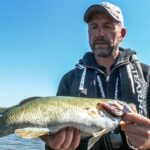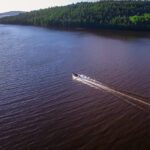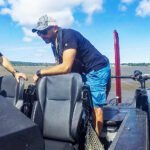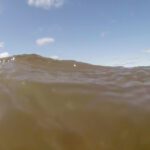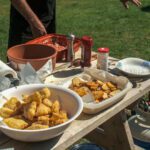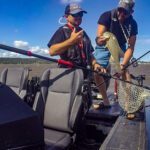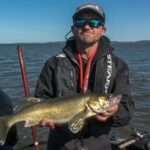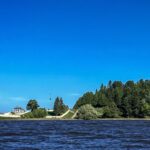On this Fish’n Canada episode, I (Pete Bowman) reunited with good buddy John Blanchard. Both Ang and I have shot with John and we certainly know how hardcore he is as an angler.
He’s also a fishing guide, which means he knows his way around pretty much any water he fishes. And he knows how to put fish in the boat under not-so-ideal conditions.
John now resides on the shore of Lake Temiskaming in northeastern Ontario. He says this lake is one of the most unique Walleye lakes he’s ever fished.
That’s what brought me there; I love Walleye and I love fishing new bodies of water.
THE NARROWS
The first day of our trip had us fishing “the Narrows.” It’s an area of Temiskaming pretty much within eye-shot of the Old Mission Resort, my home base for the shoot. The Narrows are situated at the south end of the lake, essentially where it necks down into more of a river formation. A big river that is!
The most impressive statistic of this lake is the claim of end-to-end Walleye and Smallmouth, spanning an amazing 100 kilometres!
The conditions were great for Walleye: a decent wind and tolerable temperatures. However, the forecast wasn’t so good.
John and I caught some great fish, including a bulldog of a Walleye and a beauty bonus smallie, but we could see the bad weather moving in from the north—not a nice sight on a lake as large as Temiskaming.
As our day progressed, that nasty storm blew in as predicted.
Sometimes conditions get to be too much and this day fit that bill. It was time to get off the water, light a fire at the cabin and wait for the storm to blow over. Weather permitting, we’d hit the lake again the following day.
THE LAKE
Lake Temiskaming is unique in that it’s Ontario’s portion of the headwaters for the Ottawa River.
This massive body of water is approximately 110 kilometres in length and covers an area of almost 295 square kilometres. In one area, the lake has been sounded at 709 feet deep.
The name Temiskaming is from the Algonquin Temikami or Temikaming, meaning “deep waters”.
There are 30 species of fish in the lake, including what John and I were after—Walleye and Smallmouth.
THE NORTH END
We started our next day on the north end of the lake near Temiskaming Shores, formerly known as New Liskeard.
What a difference in weather. This day brought high, bluebird skies and gorgeous temperatures.
The north end is a very popular area for local anglers since there’s great Walleye fishing within a couple of kilometres from the town. The fishing techniques vary from boat to boat here; lots love dunking live minnows while others love to troll.
John and I decided to troll for two reasons. First, the lake has extremely low visibility at the north end, so covering water with loud, rattling, vibrating crankbaits would be perfect. Second, it worked yesterday, so why change?
FISHING TECHNIQUES
We were trolling small- to medium-sized crankbaits about a hundred feet back with baitcast reels for the most part. I did use a long spinning rod as well, as it set up perfectly for trolling.
Bright colours worked great for us, and the baits with the loudest rattling and tightest vibrations seemed to work best: Scatter Raps, Hot N Tots, Thin Fins, Salmos, Thundersticks, etc.
Braid is perfect here because of the dirty water. The fish really can’t see it (or don’t care). You can feel or see every bite and the hooks pretty much set themselves. The downside of straight braid to the lure is the lack of shock absorption once the fish gets close to the boat. I’d highly suggest either a limber trolling rod or a piece of fluorocarbon or, even better, monofilament as a leader. Around ten feet is good.
HOW’D WE FARE?
I know John was a little disappointed by our low number of big fish. But hey, that’s the way it goes. We caught a couple of great Walleye and a couple of beauty smallies. We caught loads of eating-sized Walleye, and I learned a lot about fishing these creatures in low-visibility water. Best of all, we had an awesome Captain John Blanchard shore lunch. That’s worth the trip alone!
I most definitely plan on returning to this daunting yet rewarding body of water. If in John’s mind the fishing was slow on this trip, I can’t imagine how it would be when it’s on fire.
FROM THE OLD MISSION RESORT WEBSITE:
With one-and-a-half kilometress of shoreline, Old Mission Resort is located on 288 acres of pristine landscape overlooking scenic Lake Temiskaming. The property encompasses Mission Point, the site where, in 1866, Temiskaming Districts first church, school and hospital were built. The site fostered relations between the French, English and Algonquin people, who came together to trade at Fort Temiskaming, a Hudson’s Bay Trading Post located nearby on the Quebec side of the lake. Historically, Indigenous people frequented the area for over 6,000 years—undoubtedly for the abundant fishing and hunting opportunities that still entice people to the area today.
THE STORY BEHIND OLD MISSION RESORT
By the mid-1800s, logging operations were in full swing in the area where log booms would float down Lake Temiskaming and the Ottawa River System. To speed logging operations in the spring of 1882, the steamer “Mattawan” departed from the town of Mattawa travelling upstream on the Ottawa River. It was winched over four sets of rapids before finally making it to the bottom end of Lake Temiskaming. As one of the only inhabited areas of the region, the Old Mission was poised to welcome this first steamboat on Lake Temiskaming as the Mattawan arrived on its shores June 4th, 1882—literally with steam whistles blowing!
Over a period of 80 years, more than 50 boats steamed on Lake Temiskaming. Some, like the Mattawan and Lady Minto, were for towing log booms. Others, like the Meteor and Temiskaming, were used to transport freight, mail and settlers to the region, or chartered for sightseeing and picnic excursions. Some others, like the Silverland and the Scotchman, were used during the Cobalt Silver Rush days and as a fishing tug respectfully. Together, these steamships started endless opportunities for the Temiskaming District.
Today, Old Mission Resort pays tribute to these important steamboats and much of our theme is developed based on them.
SPECIAL THANKS




